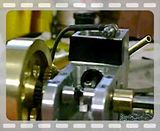Hi Chuck and fellow model builders,
NAMES was crazy busy on Sat. so I'm not sure who all I talked with.
To address the problem Chuck is having and also with some reed switches and points set ups. My CDI is triggered via a logic circuit. What that means is, the WHITE wire, by what ever means, must be pulled to ground. When it is released the CDI fires the coil. What I have heard and seen over time is when the CDI fires when the points close, it is due to point bounce OR the points MOVING when they close. This bounce or rubbing action can only be seen on an Oscilloscope. The logic circuit in the CDI is very sensitive and can detect closing and opening in the micro second and possibly even nano second range. So, any switch that is not 100% clean when they make and break can trigger the CDI. For the past year, I have instructed anyone with a points issue to set the point gap in the .003" range. The CDI does not have dwell time like the old Kettering system does. My logic being, if the points don't have to move far, then there is less chance they could bounce or slide together. I have also tossed out the idea of using a switch/points that are NORMALLY CLOSED and open only when you need the spark. The CDI doesn't care which state it is in most of the time, it just needs to change. The WHITE wire is logic HIGH and if it is held in the ground condition and only released when a spark is needed it should fire the engine reliably. This doesn't mean it won't fire when they close again but it would be after the correct spark timing and should not be a problem. Now that the new Version CDI is finalized I hope to be able to spend some time looking at remedies for the erratic operation of some micro-switches and points. I hope a small value capacitor on both the micro-switch and some points setups might eliminate the erratic firing. On most electronics with mechanical switches there is software that debounces the switch and that includes push button switches. I could program a module similar to the one used to convert our single spark to a buzz coil but that would be over kill. I am always glad to get feed back from anyone and know I have not kept up as well as I should have. It has been a struggle over the past 2-3 years with the CDI because manufactures kept obsoleting parts. With the new version CDI, I am having the transformer wound here in Ohio and I am hand soldering the components on the board so now we have complete control over the manufacturing of the CDI. If anyone has tried the normally closed points set up, I would definitely like to hear from you. I do get email updates when someone posts and now I hope to be able to keep up with what's going on. I hope this sheds some light on how the CDI operates. The reason we don't see this with the hall sensor is because it is not mechanical and by design it is in one of two states, either ON or OFF, nothing in between.
Regards,
Roy Sholl

































![DreamPlan Home Design and Landscaping Software Free for Windows [PC Download]](https://m.media-amazon.com/images/I/51kvZH2dVLL._SL500_.jpg)





























